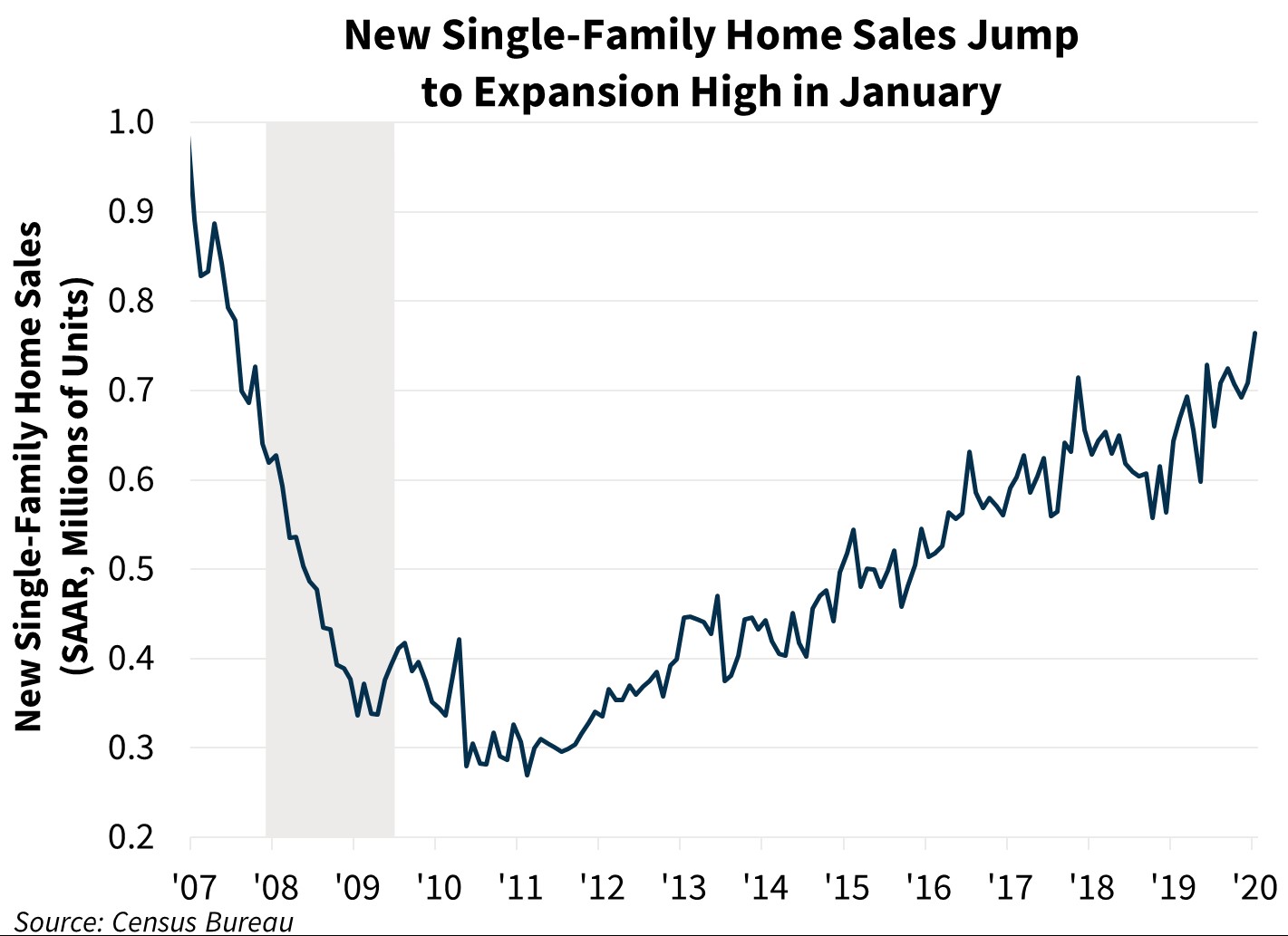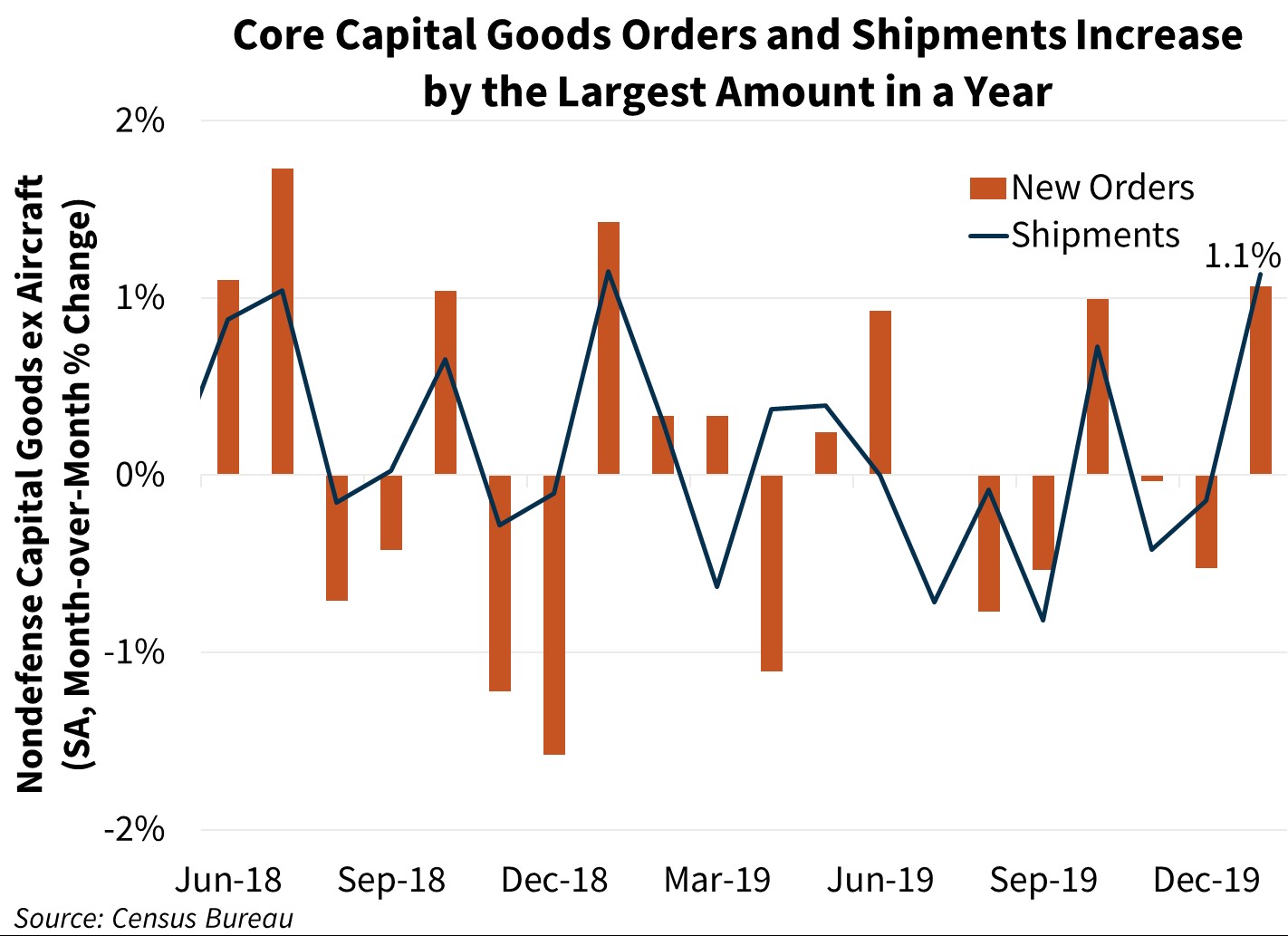Housing Continues to Show Strength, Too Early to Measure the Effects of Coronavirus
Key Takeaways:
- Real personal income rose 0.5 percent in January, according to the Bureau of Economic Analysis, the fastest pace of growth since February 2019. Real personal consumption expenditures edged up only a tenth of a percent, a modest start to the year, and the personal savings rate rose to 7.9 percent. Both the headline and core measures of year-over-year PCE inflation accelerated to 1.7 percent and 1.6 percent, respectively.
- Durable goods orders fell 0.2 percent in January, according to the Census Bureau. Excluding transportation, new orders rose 0.9 percent. Core capital goods (nondefense excluding aircraft) orders and shipments both rose 1.1 percent, with core orders rising to the highest level since October 2018.
- The University of Michigan Consumer Sentiment Index rose to 101.0 in the final February reading, the second highest reading of this expansion. While only 8 percent of all respondents mentioned the coronavirus in February, in the last two days of the collection period (February 24 and 25) the number of respondents mentioning the virus spiked to 20 percent, though this was a small portion of the overall sample.
- New single-family home sales jumped 7.9 percent in January to a new expansion high of a seasonally adjusted annualized rate of 764,000, according to the Census Bureau. The for-sale inventory declined 6.3 percent from a year ago and the months’ supply fell four-tenths to 5.1 months, the lowest since November 2017.
- The National Association of REALTORS® Pending Home Sales Index, which records contract signings of existing homes and typically leads closings by one to two months, rose 5.2 percent in January to 108.8, fully recovering from December’s sharp drop and the second highest level in over two years.
Forecast Impact
The economic data released this week do not fully reflect the effect of the coronavirus on businesses and growth.
The disruptions to production and spending associated with actual cases, fears, and quarantines could lead to a shifting of some economic activity to later this year and a meaningful reduction in U.S. economic growth in 2020 from our February forecast of 2.2 percent. The exact magnitude and timing of the effects, along with monetary and fiscal policy responses, are currently too uncertain to quantify. Supply chain disruptions and declines in travel spending and overall trade flows are the most obvious concerns.
The most immediate impact from the coronavirus in the U.S. has been a sharp downturn in the stock market, which could negatively impact consumer sentiment, spending, and investment if volatility and declines in equity persist or worsen. For now, the strength in personal income growth and the increase in the savings rate suggest that consumers still have the capacity to spend and drive growth, which supports our baseline expectation of continued strength in consumer spending in 2020 and 2021.
For the housing market, both new home sales and pending sales came in higher than expected, perhaps indicating stronger momentum to start off the year. However, unseasonably warm weather in January was likely a contributing temporary factor. While coronavirus fears may dampen housing market sentiment going forward, for now, the associated decline in interest rates will likely help bolster housing activity. According to Freddie Mac, the average yield on 30-year fixed-rate mortgages fell four basis points this week to 3.45 percent, the lowest since October 2016, and could potentially fall further if worries persist. Pent-up demand from years of inadequate new home production is also an upside risk to housing, though sales will continue to be weighed upon by the lack of inventories.


Details on Key Takeaways and Other Releases
- Personal income, adjusted for inflation, rose 0.5 percent in January, according to the Bureau of Economic Analysis. Real PCE grew by just 0.1 percent while real disposable income rose 0.5 percent. The personal saving rate rose four-tenths to 7.9 percent, the highest since April 2019. Both the PCE and the core PCE price index increased by 0.1 percent. From a year ago, the PCE price index rose 1.7 percent, an acceleration of two-tenths from December. The core PCE price index rose 1.6 percent on an annual basis, an acceleration of one-tenth.
- Durable goods orders fell 0.2 percent in January, according to the Census Bureau, though December orders were revised up five-tenths to a 2.9 percent increase. New orders for defense goods fell sharply after spiking in December. Shipments of durable goods fell 0.2 percent, while durable goods inventories were unchanged.
- The University of Michigan Consumer Sentiment Index rose 1.2 points to 101.0 in the final February reading. According to the press release, “[in] the last days of the February survey, 20% [of respondents] mentioned the coronavirus due to the steep drop in equity prices as well as the CDC warnings about the potential domestic threat of the virus.” Consumer sentiment regarding current economic conditions was relatively flat, rising 0.4 points to 114.8. Consumer expectations increased 1.6 points to 92.1, the highest level since May 2019. Inflation expectations for the next five years fell two-tenths to 2.3 percent.
- New single-family home sales jumped 7.9 percent in January to a seasonally adjusted annualized rate of 764,000, according to the Census Bureau. Sales in the prior three months were revised upward by 11,000. Regionally, new home sales rose in every region but the South. The single-family median sales price (not seasonally adjusted) rose 14.0 percent from a year ago, the largest jump since September 2015.
- The National Association of REALTORS® Pending Home Sales Index rose 5.2 percent in January to 108.8. Sales were driven by growth in the South, Midwest, and Northeast, while sales fell in the West. From a year ago, pending home sales were up 5.7 percent.
Ricky Goyette
Economic and Strategic Research Group
February 28, 2020
Opinions, analyses, estimates, forecasts and other views of Fannie Mae's Economic and Strategic Research (ESR) Group included in these materials should not be construed as indicating Fannie Mae's business prospects or expected results, are based on a number of assumptions, and are subject to change without notice. How this information affects Fannie Mae will depend on many factors. Although the ESR group bases its opinions, analyses, estimates, forecasts and other views on information it considers reliable, it does not guarantee that the information provided in these materials is accurate, current or suitable for any particular purpose. Changes in the assumptions or the information underlying these views could produce materially different results. The analyses, opinions, estimates, forecasts and other views published by the ESR group represent the views of that group as of the date indicated and do not necessarily represent the views of Fannie Mae or its management.
